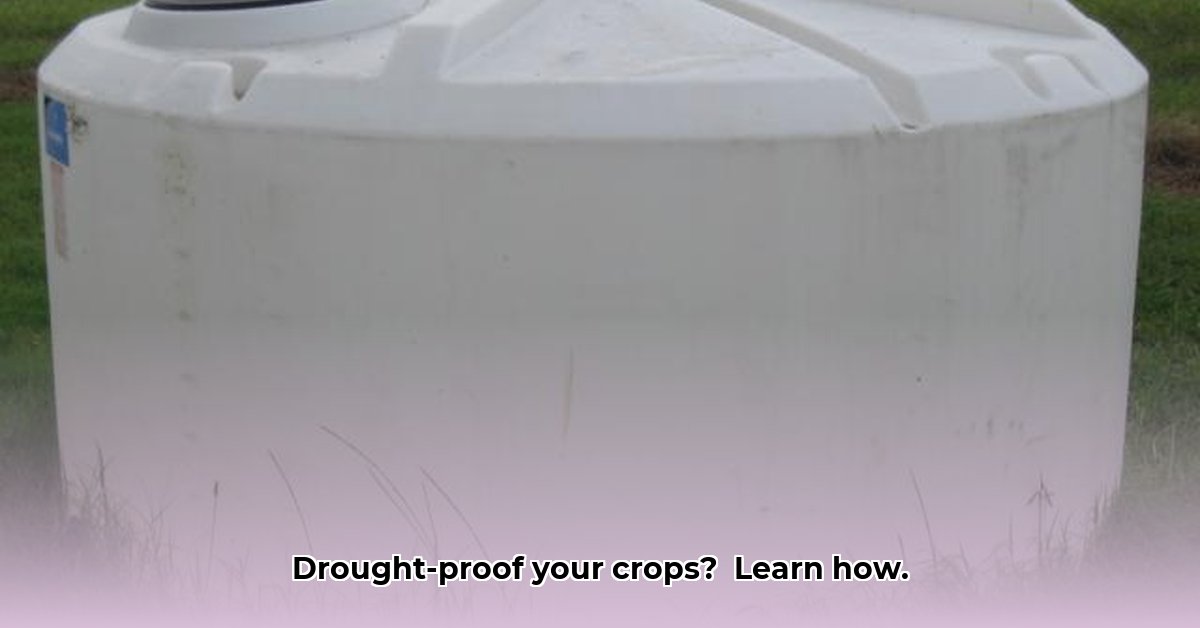
Poly Tanks Tractor Supply: Your Drought Resilience Solution
Facing unpredictable weather patterns and increasingly frequent droughts? Securing a reliable water source for your crops is paramount. Poly tanks from Tractor Supply offer a durable, versatile, and cost-effective solution to safeguard your harvest and boost your yields, even during extended dry spells. This guide provides practical advice on selecting, installing, and maintaining these essential water storage solutions. For more information on hay storage solutions, check out this helpful resource.
Assessing Your Water Needs: A Crucial First Step
Before purchasing a poly tank, accurately assess your farm's water requirements. This isn't guesswork; it's about precision planning. Consider these factors:
- Crop Type and Size: Different crops have varying water needs. Larger fields require proportionally more water.
- Irrigation Frequency: How often do you need to irrigate? This depends on your climate, soil type, and crop.
- Average Rainfall: Account for your region's typical rainfall patterns to determine your supplemental water needs.
- Livestock Needs (if applicable): Factor in water consumption for livestock if relevant.
"Accurately estimating your water needs is fundamental to selecting the right tank size," says Dr. Emily Carter, Agricultural Extension Specialist at Purdue University. "Underestimating can lead to water shortages during critical periods, while overestimating leads to wasted resources."
Choosing the Right Poly Tank: Size, Durability, and Placement
Tractor Supply offers various poly tank sizes and models. Consider these aspects:
- Tank Capacity: Select a tank size that comfortably meets your estimated water needs, allowing for some extra capacity. A slightly larger tank is better than running short.
- Durability and UV Resistance: Look for tanks made from UV-resistant polyethylene to withstand sun exposure and prolong their lifespan. Consider the impact of freezing temperatures in colder climates.
- Tank Placement: Choose a level, accessible location near your irrigation system to minimize pumping costs and maximize efficiency. Multiple smaller tanks strategically placed can enhance efficiency.
- Budget: Poly tanks come in various price ranges. Set a budget beforehand to narrow your choices.
Setting Up Your Poly Tank: A Step-by-Step Guide
Proper installation is crucial for tank longevity and safety. Follow these steps:
- Prepare a Level Base: Ensure a level, firm base free of rocks, debris, and vegetation. A concrete base is recommended for larger tanks.
- Secure the Tank: Use appropriate supports to prevent tilting or shifting. Consult the manufacturer's instructions for specific guidance.
- Connect Plumbing (if applicable): If you're integrating your tank with an irrigation system, ensure the plumbing is correctly installed and sealed to prevent leaks.
- Regular Inspection: Periodically inspect your tank for leaks, cracks, or other damage. Clean the tank to prevent algae growth.
Rainwater Harvesting: A Sustainable Water Source
Integrating rainwater harvesting with your poly tanks significantly boosts drought resilience. Channel rainwater from rooftops or other collection areas into your tanks. This free water source reduces reliance on municipal water and lowers environmental impact.
Poly Tanks vs. Other Water Storage Options: A Comparison
While poly tanks offer cost-effectiveness and ease of installation, other options exist. Let's compare:
| Tank Type | Pros | Cons |
|---|---|---|
| Polyethylene (Plastic) | Affordable, lightweight, easy installation | Less durable than steel, susceptible to UV damage |
| Steel | Durable, long-lasting | More expensive, potential for rust and corrosion |
| Underground | Space-saving | Complex installation, difficult to inspect and maintain |
Maintaining Your Poly Tank: Extending its Lifespan
Regular maintenance is key to maximizing your investment. Regularly inspect for leaks, clean the tank to prevent algae growth, and address any issues promptly. This will extend your tank's lifespan considerably.
The Bottom Line: Investing in Drought Resilience
Investing in poly tanks from Tractor Supply is a proactive step towards building drought resilience on your farm. It's an investment in your future and the sustainability of your operations. Consult your local agricultural extension office and visit Tractor Supply to explore your options and start planning your water storage solution today.